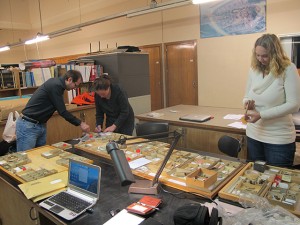CSUN Paleoanthropologist Discovers First-Ever Cannibalized Neandertal Remains in Northern Europe
California State University, Northridge paleoanthropologist Hélène Rougier has uncovered one of the biggest finds in her field — the first identified remains of cannibalized Neandertals in Northern Europe.
The remains are part of the 21-drawer collection of bones excavated from the Goyet cave in Belgium found more than 150 years ago and are stored at the Royal Belgian Institute of Natural Sciences. Details of Rougier’s discovery were published in the science journal Scientific Reports on July 6.

CSUN anthropology professor Hélène Rougier (center) identifies human skeletal remains among the collections from the Goyet cave in Belgium with colleagues from her project team, paleoanthropologist Dr. Isabelle Crevecoeur from Bordeaux University (right) and archeozoologist Cédric Beauval from Archéosphère in France (left). Photo provided by Hèléne Rougier.
The cannibalized remains had gone unnoticed for more than 150 years, Rougier said.
“Because the remains are cannibalized, they were broken … [the Neandertals] really broke the bones in many pieces,” she said. “We put aside bones that we wouldn’t have selected normally because they were not diagnostically human. Then we made a puzzle and put them together to show human bones.”
Rougier said the cannibalized remains were located near Neandertal burial sites that are clustered within a 250 kilometer diameter — some as close as 20 kilometers away. She said the findings show that Neanderthals were aware of their dead and had culture, but do not conclusively reveal the reason behind cannibalism.
“It is very interesting how [Neandertals] treated their dead in different ways,” Rougier said. “We are really wondering what it means. Are these enemies? Are these people of their own group? Unfortunately, these are questions we cannot answer. What we know is that they had culture and had some complex behaviors. We don’t know if they made a point to treat them like this.”
Rougier said the discovery was made possible by the interdisciplinary nature and collaboration of other researchers, such as fellow paleoanthropologist Isabelle Crevecoeur and archaeozoologist Cédric Beauval, who together determined the remains were indeed Neandertal and cannibalized.
Beauval was looking at the Goyet collection to study animal bones and their usage for retouching stone tools by Neandertals compared to the remains of the Neandertals found. While examining smaller bone fragments, Rougier said, Beauval noted retouching marks, bore holes that went through the bone for Neandertals to get marrow and defleshing scrape marks that were done when the bones were fresh.
“Cédric noted the presence of cut marks on the remains,” Rougier said. “He also studied a sample of the animal remains to compare it to the [Neandertal] remains. Cédric said [the Neandertals] actually really processed them intensively. They really broke the bones in many pieces.”
The Neandertal remains had portions of mitochondrial DNA in them, which two geneticists, Cosimo Posth and Johannes Krause, used to determine the ancestry of the bones to at least three different people who came from part of the latest known generations of Neandertals, Rougier said.
“We sent the samples to be directly dated and got results that fitted with what we knew were Neandertal times. Some came back too young,” she said. “We tried to get better dates. We got dates that were again really young. We realized there were early modern human remains in [the cave] as well.
“It’s really a multidisciplinary study,” Rougier said. “We had to put the results of different fields to get the results in the article. We identified some human remains with [Crevecoeur], and we checked that they were indeed Neandertal through DNA testing done by the geneticists. We communicated a lot. We knew when one field got some results, we compared them to the results of another field in the study.”
Rougier and some of her colleagues currently are excavating at Saint-Césaire, a cave in western France, where a Neandertal’s remains were found buried in a pit in 1979. Rougier said she aims to continue updating older studies with the use of new technology.
“By doing this work and by using state-of-the-art methods like DNA analysis, we can give a second life to this site on which the work had not been done using today’s standards because it was done early on,” she said. “We are now trying to set the record straight.”

 experience
experience